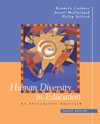 |
1 |  | 
Which of the following interconnectedness among people and nation-states is characteristic of globalization? |
|  | A) | economic systems |
|  | B) | political systems |
|  | C) | communication systems |
|  | D) | all of the above |
 |
 |
2 |  | 
According to the authors, the following benefits result from a global perspective toward education, except: |
|  | A) | Individuals are discouraged from comprehending their own condition in the community. |
|  | B) | Individuals are helped to make more accurate and effective judgments about other people and about common issues. |
|  | C) | Individuals are introduced to the study of nations, cultures, and civilizations, including our own pluralistic society, and they focus on how these are interconnected, how they change and what their roles are in such a world. |
|  | D) | Individuals are provided with a realistic, balanced perspective on world issues. |
 |
 |
3 |  | 
A society in which people are able to obtain daily needs from within their small, closed society is called a: |
|  | A) | national-modern level |
|  | B) | local-traditional level |
|  | C) | global perspective level |
|  | D) | global-postmodern level |
 |
 |
4 |  | 
In societies characterized as "national-modern" there is: |
|  | A) | more need to keep to oneself and to use only one's own resources |
|  | B) | less need to communicate with other societies |
|  | C) | a great deal of need to understand other societies |
|  | D) | a need to communicate with others because resources are inadequate |
 |
 |
5 |  | 
The element of a global perspective that refers to an understanding of how world ecosystems operate is: |
|  | A) | knowledge of the state of the planet |
|  | B) | knowledge of cross-cultural awareness |
|  | C) | knowledge of global dynamics |
|  | D) | knowledge of human choice |
 |
 |
6 |  | 
Hanvey referred to the need to consider the implications of expanded knowledge, economic, and communication systems and the potential power of individuals to make change as: |
|  | A) | a knowledge of global dynamics |
|  | B) | an awareness of human choice |
|  | C) | cross-cultural awareness |
|  | D) | perspective consciousness |
 |
 |
7 |  | 
Which of the following are not examples of effective pedagogical practices in a global classroom? |
|  | A) | creative use of technology |
|  | B) | traditional practices, e.g., lecturing and questioning |
|  | C) | requiring students to do their own work and not talk with others |
|  | D) | developmentally appropriate practices |
 |
 |
8 |  | 
Which of the following are effective roles for teachers and other adults in a global classroom? |
|  | A) | traditional teacher-student roles |
|  | B) | multiple roles for adults in the classroom |
|  | C) | multiple roles for students in the classroom |
|  | D) | all of the above |
 |
 |
9 |  | 
Which of the following is an example of internationalizing the disciplines? |
|  | A) | reinstitutionalizing Dick and Jane books |
|  | B) | study of the effect of technology and the economy on the natural environment |
|  | C) | the requirement of one year of a foreign language for all students |
|  | D) | a thorough study of American history |
 |
 |
10 |  | 
Which of the following is not an ethical issue with respect to institutionalizing a global perspective in classrooms and schools? |
|  | A) | fair allocation of available resources in the school |
|  | B) | consideration of local families and communities when discussing global concerns |
|  | C) | an emphasis on advocacy for global issues |
|  | D) | the length of time devoted to absorbing and understanding new ideas |
 |



 2003 McGraw-Hill Higher Education
2003 McGraw-Hill Higher Education